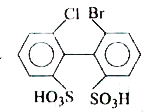Which of the following set of isomerism is possible simultaneously
in isomeric pair of compound ?
chain and position isomerism
function and metamerism
position and functional isomerism
position and metamerism
The correct Answer is:D
To solve the question regarding which set of isomerism is possible simultaneously in an isomeric pair of compounds, we will analyze the types of isomerism mentioned and determine if any can coexist in the same compound.
1. Understanding Isomerism:
- Isomerism occurs when two or more compounds have the same molecular formula but differ in the arrangement of atoms or groups within the molecules.
2. Types of Isomerism:
- Chain Isomerism: Different arrangements of the carbon skeleton (e.g., straight-chain vs. branched-chain).
- Position Isomerism: Different positions of a functional group or substituent on the carbon chain.
- Functional Isomerism: Different functional groups (e.g., alcohol vs. ether).
- Metamerism: Different alkyl groups attached to the same polyvalent functional group.
3. Analyzing Possible Combinations:
- Chain and Position Isomerism: These can occur simultaneously. For example, you can have a branched chain with a functional group in different positions.
- Position and Functional Isomerism: These cannot occur simultaneously since a change in position typically involves the same functional group.
- Metamerism and Position Isomerism: These can occur simultaneously, especially in compounds like ketones where the position of the carbon chain can vary while maintaining the same functional group.
4. Conclusion:
- The only combination that can occur simultaneously in a compound is Position Isomerism and Metamerism. For example, in ketones, you can have different positions of the carbon chain (position isomerism) while also having different alkyl groups (metamerism).
Final Answer:
The correct answer is that Position Isomerism and Metamerism can occur simultaneously in an isomeric pair of compounds.
- Isomerism occurs when two or more compounds have the same molecular formula but differ in the arrangement of atoms or groups within the molecules.
- Chain Isomerism: Different arrangements of the carbon skeleton (e.g., straight-chain vs. branched-chain).
- Position Isomerism: Different positions of a functional group or substituent on the carbon chain.
- Functional Isomerism: Different functional groups (e.g., alcohol vs. ether).
- Metamerism: Different alkyl groups attached to the same polyvalent functional group.
- Chain and Position Isomerism: These can occur simultaneously. For example, you can have a branched chain with a functional group in different positions.
- Position and Functional Isomerism: These cannot occur simultaneously since a change in position typically involves the same functional group.
- Metamerism and Position Isomerism: These can occur simultaneously, especially in compounds like ketones where the position of the carbon chain can vary while maintaining the same functional group.
- The only combination that can occur simultaneously in a compound is Position Isomerism and Metamerism. For example, in ketones, you can have different positions of the carbon chain (position isomerism) while also having different alkyl groups (metamerism).
The correct answer is that Position Isomerism and Metamerism can occur simultaneously in an isomeric pair of compounds.
Topper's Solved these Questions
- TEST PAPERBOOK - ALLENCHAPTER - TEST PAPEREXERCISE - Exercise (Chemstry)
26 Videos
- TEST PAPERBOOK - ALLENCHAPTER - TEST PAPEREXERCISE - Exercise (Chemstry)
26 Videos
- SURFACE CHEMISTRY BOOK - ALLENCHAPTER - SURFACE CHEMISTRY EXERCISE - ASSERTION & REASO
20 Videos
- TEST PAPER 1BOOK - ALLENCHAPTER - TEST PAPER 1EXERCISE - CHEMISTRY
11 Videos
Similar Questions
Knowledge Check
Geometrical isomerism is possible in :
A B
B C
C D
D
Geometrical isomerism is possible in :
A B
B C
C D
D
Which of the following will show optical isomerism?
A B
B C
C D
D
In which of the following cases functional isomerism is not possible?
View SolutionWhich of the following will show optical isomerism? .
View SolutionWhich of the following represents functional isomerism ?

View SolutionWhich of the following shows coordination isomerism?
View SolutionIn which of the following, functional group isomerism is not possible ?
View Solution
